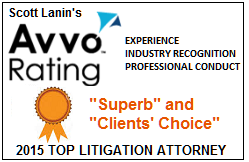What do you if someone with no legal rights to your trademark or name sets up a domain that is confusingly similar?
There are generally two options. You can (1) bring a proceeding under the provisions of an international arbitration system known as the Uniform Dispute Resolution Process (UDRP) administered by the Internet Corporation of Assigned Names and Numbers (ICANN), or (2) sue in Federal Court under the The Anticybersquatting Consumer Protection Act (ACPA).
In order to stop a cybersquatter, you must prove the domain name registrant had bad-faith intent to profit from your distinctive name or trademark and that the domain name is identical or confusingly similar to your name or trademark.
Arbitration is usually less expensive than an action. However, some clients prefer to file an action (court case) to gain more leverage or a bigger perceived threat. Arbitration may take many months to try to gain control or ownership of a domain name. With a lawsuit, the court can issue an injunction to try to stop the other party from using a domain name. So if time is of the essence and matters more to the client than the fees, then a legal action with a motion by order to show cause for a temporary restraining order may be the best option. Of course, litigation can also be unpredictable and the amount of time involved can sometimes depend on factors beyond your control, like whether discovery (exchanging evidence) becomes protracted, complex or voluminous, what defenses, challenges or obstacles are interposed by the other party, and whether the court requires multiple appearances during the case.
Needless to say, it is a better approach to try to settle if possible. It can sometimes be more cost-effective to send a cease and desist letter to the other party and to then try to buy the domain from that party. This may cost less than the legal fees for arbitrating or litigating. Sometimes another party may decide to settle for a small fee rather than pay an attorney to defend an arbitration or action.
My firm usually suggests that this type of dispute be handled in two stages in order to make this more economical: first, we conduct some research as needed to locate and confirm the identity of the other party and make a demand in writing, and then, if possible, negotiate a settlement that results in our client obtaining ownership and control of the offending domain; second, if a negotiated settlement is not possible, we can file an arbitration or action and try to gain possession of the domain through the legal process. This type of work is usually handled on an hourly fee basis. By splitting the scope of legal work into two stages, clients have an economcal solution – they avoid a large up front retainer and have the option to pursue the second stage at their discretion if they think it is worth it, after we see how the first stage works out.
If you have any legal questions or need help with internet law or domain squatters, please contact Attorney Scott Lanin at (212) 764-7250 x 201 or use the contact form in the right sidebar.



